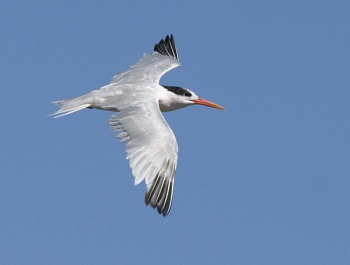Nutcracker (talk | contribs) m (cat) |
(Imp sizes. References updated) |
||
| Line 3: | Line 3: | ||
''Sterna elegans'' | ''Sterna elegans'' | ||
==Identification== | ==Identification== | ||
| − | + | 39–43 cm (15¼-17 in); a medium-large tern | |
*Pale grey upperparts | *Pale grey upperparts | ||
*White underparts | *White underparts | ||
| Line 38: | Line 38: | ||
'''Call''': a characteristic loud grating noise similar to a [[Sandwich Tern]]. | '''Call''': a characteristic loud grating noise similar to a [[Sandwich Tern]]. | ||
==References== | ==References== | ||
| − | #{{Ref- | + | #{{Ref-Clements6thAug16}}#Avibase |
# Howell & Webb, 1995. A guide to the birds of Mexico and northern Central America. Oxford University Press. ISBN 0198540124 | # Howell & Webb, 1995. A guide to the birds of Mexico and northern Central America. Oxford University Press. ISBN 0198540124 | ||
# Restall et al. 2006. Birds of Northern South America. Yale University Press. ISBN 9780300124156 | # Restall et al. 2006. Birds of Northern South America. Yale University Press. ISBN 9780300124156 | ||
Revision as of 22:52, 7 June 2017
- Thalasseus elegans
Sterna elegans
Identification
39–43 cm (15¼-17 in); a medium-large tern
- Pale grey upperparts
- White underparts
- Black legs
- Long, slender orange bill, often with yellow at tip and more so in winter
- White forehead in winter plumage
- Black crest is very long, reaching the nape in breeding plumage
Juveniles have a scalier pale grey back.
Similar Species
May be confused with the larger Royal Tern, which has a thicker bill and has more white on the forehead in winter. The bill of Royal is often a darker orange with less yellow, but even more important is the difference in shape, with Elegant slightly down-curved. The black crest stops at the eye, whereas in Elegant, the black extends down through to a spot in front of the eye.
Lesser Crested Tern, which is slightly darker above and has a grey rump. The bill is slightly shorter and thicker. The crest is rather neater.
Distribution
The Americas: Breeds on the Pacific coasts of southern California, Baja California and mainly around the Gulf of Mexico in Mexico. Post breeding dispersal both north and east, where vagrants recorded to British Columbia, Texas and very rarely as far as Florida. Winters off Pacific coast of South America (mostly Ecuador to Chile).
Western Palearctic: vagrants recorded in Ireland and Spain, there are several records from France and recent records from Denmark and Britain. From the mid-1970s to mid-1980s an Elegant Tern was present each summer in a Sandwich Tern colony on the Banc d'Arguin on the western coast of France and paired with a Sandwich Tern. Another, or the same, individual was present from 1987 to at least 1996. In 1984 there were two mixed pairs and hybrid young have been produced. Recorded for the first time in Denmark in the summer of 2000 and in May 2002 the first for Britain was a bird at Dawlish Warren in Devon. The latter bird reappeared at the same site in July and later in Gwynned, Wales.
Taxonomy
This is a monotypic species[1].
Subspecies T. e. ichlus is generally considered invalid[2].
Some authorities still places Elegant Tern in the genus Sterna but Thalasseus is more common in updated sources.
Habitat
Breeds in sandy to rocky shores and islands with 95% of the population breeding on the rocky island "Isla Rasa" in Mexico. In winter will spend the night on sand or mudflats on the coast. Feeding is in the sea (but near the shore) and in coastal lagoons.
Behaviour
Diet
They feed by plunge-diving for fish. It usually dives directly, and not from the "stepped-hover" favoured by the Arctic Tern.
Breeding
The male offers a fish to the female as part of the courtship display.
Vocalisation
Call: a characteristic loud grating noise similar to a Sandwich Tern.
References
- Clements, J. F., T. S. Schulenberg, M. J. Iliff, D. Roberson, T. A. Fredericks, B. L. Sullivan, and C. L. Wood. 2016. The eBird/Clements checklist of birds of the world: v2016, with updates to August 2016. Downloaded from http://www.birds.cornell.edu/clementschecklist/download/
- Avibase
- Howell & Webb, 1995. A guide to the birds of Mexico and northern Central America. Oxford University Press. ISBN 0198540124
- Restall et al. 2006. Birds of Northern South America. Yale University Press. ISBN 9780300124156
- Alvaro Jaramillo. 2003. Birds of Chile. Princeton Field Guides. ISBN 0-691-11740-3
- Wikipedia
Recommended Citation
- BirdForum Opus contributors. (2024) Elegant Tern. In: BirdForum, the forum for wild birds and birding. Retrieved 21 May 2024 from https://www.birdforum.net/opus/Elegant_Tern





